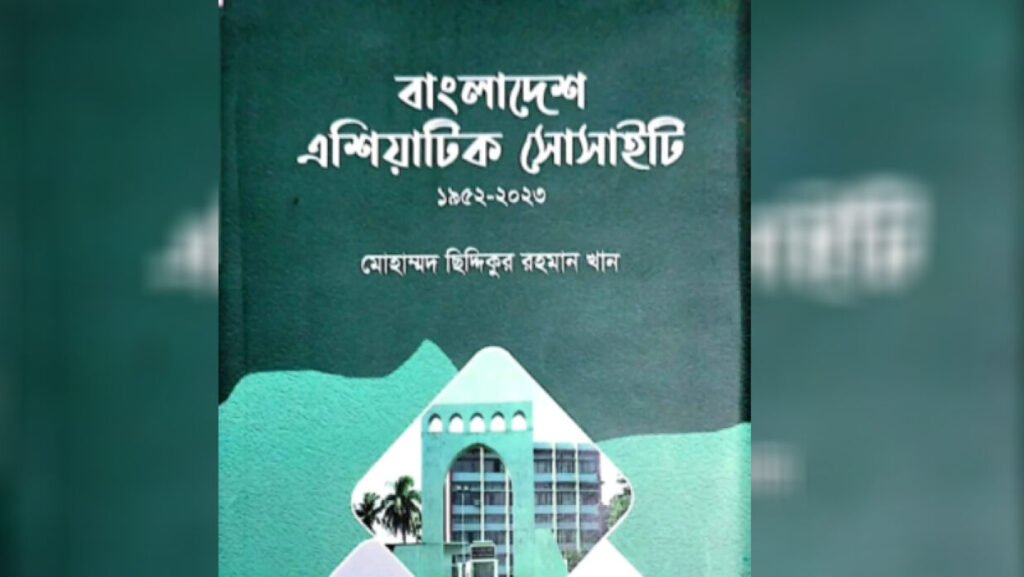The book ‘Bangladesh Asiatic Society 1952-2023’ has been published recently. Professor Mohammad Siddikur Rahman Khan of the Department of Islamic History and Culture of Dhaka University has presented his research findings and analysis in this book. After reading it, the reader’s reaction is highlighted.
Book: Bangladesh Asiatic Society 1952-2023
Book Author: Mohammad Siddikur Rahman Khan
Publication: History Publications/September 2023
Chapter: 4; Page number 176
In commemoration of the ‘Asiatic Society’ established in Calcutta by William Jones from the desire to know the people and nature of Asia, the intellectual society of Dhaka has built the ‘Bangladesh Asiatic Society’ with almost the same purpose.
Chapter 1: Jones’s ‘Asiatic Society’, Dr. Muhammad Shahidullah’s ‘Oriental Academy’, intellectuals’ ‘Asiatic Society of Pakistan’, and the ‘Bangladesh Asiatic Society’ from Independence North’s ‘Bangladesh Asiatic Society’ are prefaces to chapter 1 of the book on intellectual practice, institutions and institutional structures, individuals and their activities. .
The practice and necessity of Orientalism by the British rulers of the subcontinent will surely stir the thoughtful reader. In particular, Jones thought that he should build a research institute to know the people and nature of Asia while sitting on the ship on his way to India! Regional characteristics and the behavior of ethnic groups without the study of this subcontinent were impossible to rule!
Chapter 2: Review of research and publications of Bangladesh Asiatic Society so far as a research institution is the subject of discussion in Chapter 2. The author briefly discusses the various studies in the detailed volume of the Society and mentions a list of 152 publications by year. A number of early published studies focused on Islam and Muslim contexts. Some of the later research topics are the history of Muslim rule and rulers. His later researches were on independence North Bangladesh and related history, literature and culture.
The research activities of the last three decades can be called a milestone in the history of the society. This chapter creates great enthusiasm in the mind of the reader to read the books published by the society. However, if the author included in the review of the early published books on ‘Islam and Muslims’, the reader could have enriched himself in the first place.
Chapter 3: A Research Institute’s 46 Trust Funds are truly astonishing. The main reason for this surprise is the multipurpose purpose of trust funds. Trust funds for research and research lectures on everything from science to arts, medicine to military, politics to finance, literature to religion, etc., are essential for every researcher at the university level. This chapter will be marked as a must read for research teachers engaged in university teaching. An Islamic studies background as a student is relevant to at least a dozen trust fund objective a review writers.
Chapter 4: In this chapter the researcher has mentioned in detail the identity of museums, art galleries and libraries of the Asiatic Society. Nimtali has brought to light a forgotten history of Palace and Deuri especially to the new generation. The success of the author is found in drawing the desire to sit and study in Nimtali museum and library in the mind of the reader. The writer of this review felt tired to suppress his eager desire to go through the manuscripts especially in Islamic, Arabic, Urdu and Persian languages.
Professor Dr. Mohammad Siddikur Rahman Khan is a history researcher. He has written a simple lesson in history. He has accomplished the difficult task of constructing a completely new structure without any precedent or precedent in very simple, clear and readable language. However, some errors in composition and printing are noticeable.
Dr. Khan’s main area of research is the political evolution of the modern Muslim world. His special interest is reading and researching South Asia, especially the political development of Bangladesh, including the liberation war. As such, he has written research books such as ‘History of Mughal India’, ‘History of Bangladesh 1972-2014’, ‘Ottoman Sultanate: Politics, Society and Culture’, ‘Elite Class of Nawabi Bengal: Politics, Society and Culture’. Among them the last mentioned book is published by the Asiatic Society. History readers can read these research books.
Therefore, I think it is worth collecting and studying the author’s book ‘Bangladesh Asiatic Society 1952-2023’ for the research interested readers especially the research teachers engaged in university teaching.

